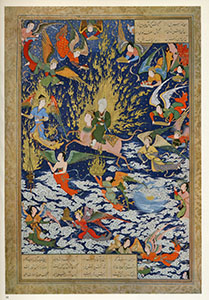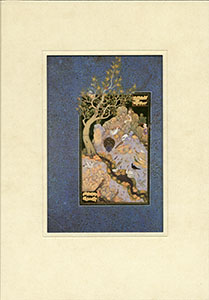
Animals in Jewish, Christian, and Islamic Illustrations from the Middle Ages

Nizami’s Khamsa (Five Poems) Muhammad’s Ascent to Heaven, Facsimile of British Library Or. MS 2265, f. 195,
Tabriz, Iran (1539 CE) Persische Miniaturen: Meisterwerke Orientalischer Buchmalerei
1940. Leipzig: Iris Druck Curt Weller & Co. Verlag
13.75 in. x 10 in.
ND3241.P4 1940 Oversize
Rare Books Collection, Special & Area Studies Collections, George A. Smathers Libraries
This facsimile of a 16th century Persian miniature provides an uncommon example of the Prophet Muhammad pictured in an Islamic manuscript. The miniature was made to illustrate a copy of five epic poems (Khamsa) by the celebrated 12th century Persian poet, Nizami Ganjavi.
Human or animal representation in a religious context is discouraged in Islam. Qur’ans are illustrated and adorned with sacred calligraphy and illumination. Yet, the story of the Prophet’s ascension to heaven had such a profound impact on Islamic thought and Sufism that the image of the ascension often appears in religious Islamic paintings, especially those produced in Persia. The ascension was a popular theme in secular literature too and images of it are often found in poetry manuscripts.
This miniature, produced by an unknown Persian artist, presents the Prophet on the winged horse-like creature, al-Buraq (meaning “lightning”), ascending to heaven with an escort of angels. According to tradition, the Prophet’s face is whitened out and made featureless. Yet al-Buraq, his steed, is almost always portrayed with a beautiful human face in far-eastern and Persian art, in spite of the fact that there are no references to an animal with humanoid features in the Hadiths or early Islamic references. This rendering of al-Buraq in Indian and Persian art was probably due to a mistranslation from Arabic into Persian from popular stories about the ascension.

Die Versammlung der Vogel (The Language of the Birds), Facsimile of a manuscript of Mantiq-al-Tayr, Iran (c. 1600 CE)
1970. Stuttgart: Verlag Müller and Schindler
15.75 in. x 11.25 in.
ND3399.A88V47 Oversize
Rare Books Collection, Special & Area Studies Collections, George A. Smathers Libraries
This illustrated page, The Conference of the Birds, is a facsimile copy of a folio from a Persian manuscript of the mystical poem The Language of the Birds (Mantiq al-Tayr). The manuscript was first compiled and illuminated in Persia under the Timurid dynasty (1370-1506) by a court atelier in Herat (Afghanistan), and it was completed and restored during the Safavid dynasty (1502-1722) by a court atelier in Isfahan (Iran).
The Language of the Birds was composed by the famous Sufi poet, Farid al-Din cAttar in the 12th-13th centuries CE. The poem is an allegorical work on the quest of Sufism (a mystical movement within Islam) to know God: the birds represent the men who follow the Sufi path. The Conference of the Birds depicts the moment when the hoopoe bird (middle right) counsels the birds to set out on a journey to find the Simurgh (a mythical bird representing the Divine).
This folio was produced in c.1600 and bears the signature of the Safavid painter, Habiballah, on a stone next to a stream. Earlier Timurid artistic motifs, such as the goats on the mountain, are visible also in the illustration. Safavid illustrators provided direct pictorial representations of the text whereas Timurid illustrators, like the Persian poets of that period, infused their art with many riddle-like motifs. Solving these riddles provided great entertainment for the rulers and influential men of the Timurid court.